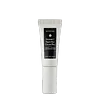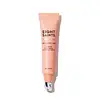What's inside
What's inside
 Key Ingredients
Key Ingredients

 Benefits
Benefits

 Concerns
Concerns

 Ingredients Side-by-side
Ingredients Side-by-side

Water
Skin ConditioningDimethicone
EmollientIsododecane
EmollientHydrogenated Polydecene
EmollientPropanediol
SolventGlycerin
HumectantIsopentyldiol
HumectantButyrospermum Parkii Butter
Skin ConditioningCaprylic/Capric/Myristic/Stearic Triglyceride
EmollientStearoxymethicone/Dimethicone Copolymer
Emollient3-O-Ethyl Ascorbic Acid
Skin ConditioningCetearyl Olivate
Cetyl Alcohol
EmollientStearyl Alcohol
EmollientSorbitan Olivate
EmulsifyingDimethicone Crosspolymer
Emulsion StabilisingSqualane
EmollientAscorbic Acid
AntioxidantOryza Sativa Bran Extract
Skin ConditioningSorbitol
HumectantMannitol
HumectantRetinol
Skin ConditioningTricaprylin
MaskingAloe Barbadensis Leaf Juice
Skin ConditioningSodium Phytate
Phosphatidylcholine
EmulsifyingRosmarinus Officinalis Leaf Extract
AntimicrobialSodium Ascorbyl Phosphate
AntioxidantHelianthus Annuus Extract
EmollientHyaluronic Acid
HumectantTocopherol
AntioxidantGlutathione
Decyl Glucoside
CleansingGold
Cosmetic ColorantPentaerythrityl Tetra-Di-T-Butyl Hydroxyhydrocinnamate
AntioxidantHdi/Trimethylol Hexyllactone Crosspolymer
Hexadecene
SolventPolymethylsilsesquioxane
Ammonium Acryloyldimethyltaurate/Vp Copolymer
Cetyl Diglyceryl Tris(Trimethylsiloxy)Silylethyl Dimethicone
Emulsion StabilisingPolysilicone-11
Dipropylene Glycol
HumectantCellulose Acetate Butyrate
Caprylyl Glycol
EmollientSilica
AbrasiveXanthan Gum
EmulsifyingCitric Acid
BufferingSilica Silylate
EmollientPotassium Sorbate
PreservativeSodium Benzoate
MaskingMagnesium Stearate
Cosmetic Colorant1,2-Hexanediol
Skin ConditioningSodium Chloride
MaskingPhenoxyethanol
PreservativeWater, Dimethicone, Isododecane, Hydrogenated Polydecene, Propanediol, Glycerin, Isopentyldiol, Butyrospermum Parkii Butter, Caprylic/Capric/Myristic/Stearic Triglyceride, Stearoxymethicone/Dimethicone Copolymer, 3-O-Ethyl Ascorbic Acid, Cetearyl Olivate, Cetyl Alcohol, Stearyl Alcohol, Sorbitan Olivate, Dimethicone Crosspolymer, Squalane, Ascorbic Acid, Oryza Sativa Bran Extract, Sorbitol, Mannitol, Retinol, Tricaprylin, Aloe Barbadensis Leaf Juice, Sodium Phytate, Phosphatidylcholine, Rosmarinus Officinalis Leaf Extract, Sodium Ascorbyl Phosphate, Helianthus Annuus Extract, Hyaluronic Acid, Tocopherol, Glutathione, Decyl Glucoside, Gold, Pentaerythrityl Tetra-Di-T-Butyl Hydroxyhydrocinnamate, Hdi/Trimethylol Hexyllactone Crosspolymer, Hexadecene, Polymethylsilsesquioxane, Ammonium Acryloyldimethyltaurate/Vp Copolymer, Cetyl Diglyceryl Tris(Trimethylsiloxy)Silylethyl Dimethicone, Polysilicone-11, Dipropylene Glycol, Cellulose Acetate Butyrate, Caprylyl Glycol, Silica, Xanthan Gum, Citric Acid, Silica Silylate, Potassium Sorbate, Sodium Benzoate, Magnesium Stearate, 1,2-Hexanediol, Sodium Chloride, Phenoxyethanol
Water
Skin ConditioningAloe Barbadensis Leaf Juice
Skin ConditioningHelianthus Annuus Seed Oil
EmollientIsopropyl Palmitate
EmollientCetyl Alcohol
EmollientGlyceryl Stearate Se
EmulsifyingGlycerin
HumectantStearic Acid
CleansingNiacinamide
SmoothingSodium Lactate
BufferingHyaluronic Acid
HumectantCamellia Sinensis Leaf Extract
AntimicrobialAvena Sativa Kernel Extract
AbrasiveCentella Asiatica Extract
CleansingEquisetum Arvense Extract
AstringentPelargonium Graveolens Extract
MaskingTaraxacum Officinale Extract
Skin ConditioningArnica Montana Flower
Skin ConditioningCalendula Officinalis Flower Extract
MaskingChamomilla Vulgaris Extract
Skin ProtectingLavandula Angustifolia Oil
MaskingCocos Nucifera Oil
MaskingSimmondsia Chinensis Seed Oil
EmollientRosa Canina Seed Oil
EmollientBoswellia Carterii Oil
MaskingCalophyllum Inophyllum Seed Oil
AntimicrobialMacadamia Ternifolia Seed Oil
EmollientBorago Officinalis Seed Oil
EmollientLinum Usitatissimum Seed Oil
PerfumingOenothera Biennis Oil
EmollientPelargonium Graveolens Leaf Oil
Theobroma Cacao Seed Butter
EmollientButyrospermum Parkii Butter
Skin ConditioningTocopherol
AntioxidantAspartic Acid
MaskingArginine
MaskingPCA
HumectantGlycine
BufferingAlanine
MaskingSerine
MaskingValine
MaskingIsoleucine
Skin ConditioningProline
Skin ConditioningThreonine
Histidine
HumectantPhenylalanine
MaskingPanthenol
Skin ConditioningBeeswax
Emulsion StabilisingSodium PCA
HumectantXanthan Gum
EmulsifyingGlyceryl Stearate
EmollientPotassium Stearate
CleansingEthylhexyl Palmitate
EmollientAlcohol
AntimicrobialSodium Carbomer
Emulsion StabilisingPotassium Sorbate
PreservativeSodium Benzoate
MaskingEthylhexylglycerin
Skin ConditioningPhenoxyethanol
PreservativeWater, Aloe Barbadensis Leaf Juice, Helianthus Annuus Seed Oil, Isopropyl Palmitate, Cetyl Alcohol, Glyceryl Stearate Se, Glycerin, Stearic Acid, Niacinamide, Sodium Lactate, Hyaluronic Acid, Camellia Sinensis Leaf Extract, Avena Sativa Kernel Extract, Centella Asiatica Extract, Equisetum Arvense Extract, Pelargonium Graveolens Extract, Taraxacum Officinale Extract, Arnica Montana Flower, Calendula Officinalis Flower Extract, Chamomilla Vulgaris Extract, Lavandula Angustifolia Oil, Cocos Nucifera Oil, Simmondsia Chinensis Seed Oil, Rosa Canina Seed Oil, Boswellia Carterii Oil, Calophyllum Inophyllum Seed Oil, Macadamia Ternifolia Seed Oil, Borago Officinalis Seed Oil, Linum Usitatissimum Seed Oil, Oenothera Biennis Oil, Pelargonium Graveolens Leaf Oil, Theobroma Cacao Seed Butter, Butyrospermum Parkii Butter, Tocopherol, Aspartic Acid, Arginine, PCA, Glycine, Alanine, Serine, Valine, Isoleucine, Proline, Threonine, Histidine, Phenylalanine, Panthenol, Beeswax, Sodium PCA, Xanthan Gum, Glyceryl Stearate, Potassium Stearate, Ethylhexyl Palmitate, Alcohol, Sodium Carbomer, Potassium Sorbate, Sodium Benzoate, Ethylhexylglycerin, Phenoxyethanol
Ingredients Explained
These ingredients are found in both products.
Ingredients higher up in an ingredient list are typically present in a larger amount.
Aloe Barbadensis Leaf Juice comes from leaves of the aloe plant. Aloe Barbadensis Leaf Juice is best known for helping to soothe sunburns. It is also anti-inflammatory, moisturizing, antiseptic, and can help heal wounds.
Aloe is packed with good stuff including Vitamins A, C, and E. These vitamins are antioxidants, which help fight free-radicals and the damage they may cause. Free-radicals are molecules that may damage your skin cells, such as pollution.
Aloe Barbadensis Leaf Juice also contains sugars. These sugars come in the form of monosaccharides and polysaccharides, folic acid, and choline. These sugars are able to help bind moisture to skin.
It also contains minerals such as calcium, 12 anthraquinones, fatty acids, amino acids, and Vitamin B12.
Learn more about Aloe Barbadensis Leaf JuiceThis ingredient is also known as shea butter. It is an effective skin hydrator and emollient.
Emollients help soothe and soften your skin. It does this by creating a protective film on your skin. This barrier helps trap moisture and keeps your skin hydrated. Emollients may be effective at treating dry or itchy skin.
Shea butter is rich in antioxidants. Antioxidants help fight free-radicals, or molecules that may harm the body. It is also full of fatty acids including stearic acid and linoleic acid. These acids help replenish the skin and keep skin moisturized.
While Shea Butter has an SPF rating of about 3-4, it is not a sunscreen replacement.
Shea butter may not be fungal acne safe. We recommend speaking with a professional if you have any concerns.
Learn more about Butyrospermum Parkii ButterCetyl Alcohol is a fatty alcohol. Fatty Alcohols are most often used as an emollient or to thicken a product.
Its main roles are:
Though it has "alcohol" in the name, it is not related to denatured alcohol or ethyl alcohol.
The FDA allows products labeled "alcohol-free" to have fatty alcohols.
Learn more about Cetyl AlcoholGlycerin is already naturally found in your skin. It helps moisturize and protect your skin.
A study from 2016 found glycerin to be more effective as a humectant than AHAs and hyaluronic acid.
As a humectant, it helps the skin stay hydrated by pulling moisture to your skin. The low molecular weight of glycerin allows it to pull moisture into the deeper layers of your skin.
Hydrated skin improves your skin barrier; Your skin barrier helps protect against irritants and bacteria.
Glycerin has also been found to have antimicrobial and antiviral properties. Due to these properties, glycerin is often used in wound and burn treatments.
In cosmetics, glycerin is usually derived from plants such as soybean or palm. However, it can also be sourced from animals, such as tallow or animal fat.
This ingredient is organic, colorless, odorless, and non-toxic.
Glycerin is the name for this ingredient in American English. British English uses Glycerol/Glycerine.
Learn more about GlycerinHyaluronic acid is naturally found in healthy skin. It is a humectant, meaning it draws moisture to your skin.
This ingredient helps hydrate, soothe, and protect the skin.
What makes hyaluronic acid so hydrating? It has the capacity to bind or hold large amounts of water.
Fun fact: It is already naturally found in our bodies, such as the fluids of our eyes and our joints.
Studies find this ingredient to have anti-inflammatory and anti-microbial properties. This can help speed up wound-healing.
Hyaluronic acid can be irritating if the molecule has a low-molecular weight, or if the molecules are small.
One study found low-molecular weight hyaluronic acid to be pro-inflammatory, meaning some people may experience irritation. This is because our bodies use hyaluronic acid in the wound-healing process to signal to our bodies, via irritation, that something needs healing.
The same study found high-molecular weight hyaluronic acid to be anti-inflammatory.
These are some other common types of Hyaluronic Acid:
Learn more about Hyaluronic AcidPhenoxyethanol is a preservative that has germicide, antimicrobial, and aromatic properties. Studies show that phenoxyethanol can prevent microbial growth. By itself, it has a scent that is similar to that of a rose.
It's often used in formulations along with Caprylyl Glycol to preserve the shelf life of products.
Potassium Sorbate is a preservative used to prevent yeast and mold in products. It is commonly found in both cosmetic and food products.
This ingredient comes from potassium salt derived from sorbic acid. Sorbic acid is a natural antibiotic and effective against fungus.
Both potassium sorbate and sorbic acid can be found in baked goods, cheeses, dried meats, dried fruit, ice cream, pickles, wine, yogurt, and more.
You'll often find this ingredient used with other preservatives.
Learn more about Potassium SorbateSodium Benzoate is a preservative. It's used in both cosmetic and food products to inhibit the growth of mold and bacteria. It is typically produced synthetically.
Both the US FDA and EU Health Committee have approved the use of sodium benzoate. In the US, levels of 0.1% (of the total product) are allowed.
Sodium benzoate works as a preservative by inhibiting the growth of bacteria inside of cells. It prevents the cell from fermenting a type of sugar using an enzyme called phosphofructokinase.
It is the salt of benzoic acid. Foods containing sodium benzoate include soda, salad dressings, condiments, fruit juices, wines, and snack foods.
Studies for using ascorbic acid and sodium benzoate in cosmetics are lacking, especially in skincare routines with multiple steps.
We always recommend speaking with a professional, such as a dermatologist, if you have any concerns.
Learn more about Sodium BenzoateTocopherol (also known as Vitamin E) is a common antioxidant used to help protect the skin from free-radicals and strengthen the skin barrier. It's also fat soluble - this means our skin is great at absorbing it.
Vitamin E also helps keep your natural skin lipids healthy. Your lipid skin barrier naturally consists of lipids, ceramides, and fatty acids. Vitamin E offers extra protection for your skin’s lipid barrier, keeping your skin healthy and nourished.
Another benefit is a bit of UV protection. Vitamin E helps reduce the damage caused by UVB rays. (It should not replace your sunscreen). Combining it with Vitamin C can decrease sunburned cells and hyperpigmentation after UV exposure.
You might have noticed Vitamin E + C often paired together. This is because it is great at stabilizing Vitamin C. Using the two together helps increase the effectiveness of both ingredients.
There are often claims that Vitamin E can reduce/prevent scarring, but these claims haven't been confirmed by scientific research.
Learn more about TocopherolWater. It's the most common cosmetic ingredient of all. You'll usually see it at the top of ingredient lists, meaning that it makes up the largest part of the product.
So why is it so popular? Water most often acts as a solvent - this means that it helps dissolve other ingredients into the formulation.
You'll also recognize water as that liquid we all need to stay alive. If you see this, drink a glass of water. Stay hydrated!
Learn more about WaterXanthan gum is used as a stabilizer and thickener within cosmetic products. It helps give products a sticky, thick feeling - preventing them from being too runny.
On the technical side of things, xanthan gum is a polysaccharide - a combination consisting of multiple sugar molecules bonded together.
Xanthan gum is a pretty common and great ingredient. It is a natural, non-toxic, non-irritating ingredient that is also commonly used in food products.
Learn more about Xanthan Gum